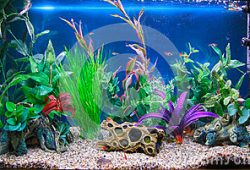Upgrading to a Higher Capability Aquarium
The article gives an analysis of Upgrading to a Higher Capability Aquarium. If you’ve been raising aquarium fish for some years already and enjoy the hobby but find that your tank’s capacity is limiting what you would like do, it might be time to upgrade to a bigger capacity. Though two hundred-gallon tanks are not suggested for beginners, they offer limitless options for an experienced hobbyist who has the time, and the creativity, to construct a beautiful display.

To start with, you have to create positive you have got the budget for this upgrade. Everything can would like to be bigger — not solely your tank but the heater, the filter, the substrate layer, the lighting, and in fact the plants and fish you will populate your tank with. You furthermore mght would like a durable piece of furniture to put your tank on. Tanks this huge usually have a footprint of half-dozen feet by two feet or more (at additional than two feet in height); and, because water weighs 8.35 pounds per gallon, your table must be able involved one,670 pounds (758 kilograms) in water, plus the weight of the tank itself, the filter and different equipment, and whatever substrate, rocks, plants, and fish you set within the tank. The table might be your biggest expense!
In choosing a tank, your initial choice can be between glass and acrylic. Most enthusiasts prefer glass, as a result of glass is abundant a lot of troublesome to scratch than acrylic; glass also maintains its clarity (some sorts of acrylic will yellow with age), and glass is cheaper. However, acrylic is a smaller amount distorting, will be molded into a variety of shapes, is lighter in weight, and is additional proof against shocks: a sharp impact can scratch the acrylic however is unlikely to shatter it, whereas glass could crack or shatter. Unless you would like a VERY massive tank (say, 500 gallons), or wish a tank in an odd shape or with bowed sides, then glass is most typically the higher choice.
As for substrate, you’ll be able to quickly calculate the number you will want to cover the underside of your tank at a median depth of 2 inches. Multiply the aquarium’s length by its width (in inches), then divide by ten. The resulting variety is the number of pounds of gravel you’ll need. Thus, if your tank is seventy two x twenty four inches, 72 times twenty four equals one,728; divided by ten, you will want 172 pounds of gravel. (If you are using another substance for your substrate layer, then you may need to see the load relative to the burden of gravel to use this formula.)
Smaller aquarium tanks are better suited for freshwater environments only, but a bigger tank can simply accommodate a saltwater setting also; you will want to contemplate a reef tank, that will enable you to prominently display live corals and other marine invertebrates, in addition to fish that play a role in maintaining a coral reef ecosystem.
The same 200-gallon tank, whether glass or acrylic, will hold either salt water or recent water, however you would like to choose a filter carefully. There are 3 primary kinds of filter: biological (that, using bacteria, converts ammonia into nitrate; mechanical (which physically removes each dissolved and particulate material from the water as it passes through); and chemical (that removes toxins through chemical reaction or absorption).
Any of these systems can work with salt water furthermore contemporary water, but you would like to make sure sufficient circulation through your filter for your giant tank. If you have got salt water, the full volume of water in your tank ought to “flip over” (suffer the filter) at least five times every hour. For a two hundred-gallon tank, thus, the filter should be capable of turning over one,000 gallons of water each hour. (For contemporary water, the turnover rate will be slightly less, however at least 3 times per hour.)
Your aquarium heater, conjointly, should have sufficient capability to maintain the correct temperature throughout your tank; as a simple rule, you need five watts of heating power for each gallon of water. Therefore if you would like to heat your 200-gallon tank approximately ten degrees on top of average area temperature, you will want as abundant as 1,000 watts of capability total. It’s best to urge two heaters at five hundred watts every and place them at opposite ends of the tank. Be positive to consult together with your dealer; if you are designing a reef tank that needs a better water temperature, as an example, you may want a lot of heating power.
The foremost common reasonably aquarium heater is an immersible heater, that hangs on the aspect of the tank, sitting partially in the water with the controls higher than the water line. These are relatively low-value, however are plainly visible. Absolutely submersible heaters can be additional simply hidden from read, however they are pricier and better suited for smaller tanks. Substrate heaters are positioned beneath the substrate layer, and are effective at promoting plant growth and heating the water uniformly. Filter heaters reside within the filter, once more hiding the heater from view.
Another piece of equipment you’ll would like to contemplate may be a powerhead: a submersible water pump that produces a unidirectional current. Powerheads are perfect for freshwater tanks housing river fish, as they can approximate river currents. They’re conjointly suitable for saltwater reef tanks, where underwater turbulence helps promote reef growth. For a reef tank, purchase 2 or a lot of oscillating powerheads and place them in numerous locations, making competing, multidirectional currents.
Once you have got a basic idea regarding the equipment you’ll want, you can then decide what sort of underwater ecosystem you want to form in your large tank. Your choice may confirm precisely how much filter you wish, or how powerful your heater wants to be, so consult carefully along with your dealer in selecting your hardware.



